Learn Your Name In Morse Code Day
Monday, 11 January 2021
.-. — – — .-. ..- .- — ..- … . ..- — (Rotorua Museum)
Ever thought about what it might be like to convey important information to someone in another town, city or country without your computer, tablet, phone, or mobile phone?

International Morse Code; James Kanjo at the English language Wikipedia, CC BY-SA 3.0, https://commons.wikimedia.org/w/index.php?curid=3703528
Back in the days of the Tarawera eruption and right through to the late 1970s, important messages were sent from post to post by telegraphy using electro-mechanical devices invented in Britain and the United States. Messages consisted of a series of short and long clicks and later, tone pulses using a version of the code originally invented by Samuel Morse in 1844. The sounds were vocalised as dahs (long sound) and dits (short sound) with the code sometimes referred to as iddy-umpty. The dash was the umpty and is the origin of the word umpteen that we use today!
The radio operator translated brief messages into Morse and tapped them into the telegraph network where they were transmitted to the telegraph office closest to their destination. The receiving operator translated the code back into words and the message was delivered to the person it was addressed to. It was an expensive business and you were charged by the word consequently most telegrams were jam packed with hyphenated words and only about 10 words long.

Key Dummy Signallers Mk II, A. T. M. Co. Ltd 1919; RSA Collection of Rotorua Museum Te Whare Taonga o Te Arawa (2016.17.20)
Operators learned to transmit Morse code using a learner’s key. On top of the brass plate is a brass fitting which holds the key itself. The key has a Bakelite knob at the end but unlike ‘proper’ Morse keys, has no terminals and no batteries.
The learner’s Morse key pictured is part of the RSA collection of Rotorua Museum and was manufactured by A. T. M. Co. Ltd in Liverpool, England, in 1919.
Roger Delamare Dansey was the telegraph operator in Rotorua at the time of the Tarawera eruption in 1886. He learned Morse code while serving in the armed constabulary after his arrival in Wellington, New Zealand in 1870. Dansey was trained to repair and maintain telegraph wires and was posted to Taupo where he was responsible for 145 kilometres of line between Taupo and Napier. It took him 5 days to travel the line.

Roger Delamere Dansey, Stafford Collection, Rotorua Museum Te Whare Taonga o Te Arawa (Rotorua) (CP-3533)
Dansey found life in the constabulary hard and made a deal to teach the radio operator in his unit French in exchange for tuition in Morse. Unfortunately the French lessons fell by the wayside and Dansey was left to teach himself. He discovered that he could make the click sound of a Morse key by fiddling with the trigger on his carbine rifle and practiced with an obsession. He persuaded his Senior Sergeant to let him take charge of the guard then posted the sentries so that he took alternate duties and was able to walk up and down practicing Morse all night long.
Late one night Dansey was asked a question by the officer in charge of the telegraph office and he responded by clicking the answer on his rifle. After that whenever the officer was keen to get away he would leave Dansey in charge of the office giving him plenty of opportunity to improve his skills. Within 18 months of clicking his carbine trigger, the officer in charge of the telegraph office in Rotorua was keen to get away and asked him if he would be willing to take his place. Seizing an opportunity to demonstrate his ability to the telegraph inspector he finally obtained the General Inspector’s permit to operate and was officially posted to the Rotorua Postal Telegraph Office which coincidently had a clear view of Mount Tarawera.
Dansey observed the splendour, terror and destruction of the early morning eruptions of the 10th June 1886 and despite the line north of Rotorua being destroyed beyond immediate repair by ash fall which coated the wires to the thickness of a candle, managed to get a faint signal out to Napier, 242 kilometres miles to the south, at 8am in the morning. He was so overjoyed to hear the responding signal, his first words were “God bless you old chap. Sgd. R.O. (Rotorua).” We can only imagine how frustratingly slow it must have been for Dansey to blurt his story out in a series of dots and dashes!
Try learning to tap out your own name using the International Morse Code chart at https://commons.wikimedia.org/w/index.php?curid=3902977.and
Wiki How– How to Learn Morse Code 12 steps with pictures:
https://www.wikihow.com/Learn-Morse-Code











